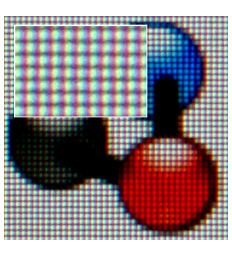LCD Displays
Recently LCD HDTVs have become very popular. Unlike DLP displays they can be very thin, and unlike plasmas they're usually relatively inexpensive. Manufacturers like Vizio have greatly increased LCD market share by selling discount HDTVs that use the technology. As a result, more established consumer electronics manufacturers are increasing output as well. Twisted liquid crystal is used to block light that's being projected. When current is applied to the crystals they will untwist to varying degrees, allowing light to pass through. Each pixel consists of a single red, blue, and green subpixel created by passing colored light through the crystals. When they're combined they form a pixel with a single color. LCD technology is used for direct view (flat panel), RPTV and front projectors.

Advantages
LCD HDTVs are reasonably priced for flat panels (compare to plasma), with recent discount models making them an even better buy. They're far lighter than CRTs and significantly ligher than DLP displays. Life expectancy of an LCD flat panel is generally longer than a plasma TV and the picture is often sharper than a DLP HDTV. LCD displays are very energy efficient - much more so than any other HDTV type.
Disadvantages
LCD rear projectors suffer from what's called the screen door effect. This is the result of gaps between LCD pixels being visible when you get close enough to the screen. The quality (blackness) of blacks on an LCD TV is lower than other technologies. resolution is an issue with many LCD displays actually being EDTVs instead of HDTVs. This will produce excellent results from SDTV or DVD signals, but much lower quality with actual HDTV content. Finally, individual pixels can burn out, turning permanently either white or black.Technology Advancements
There have been many advancements in LCD technology over the last couple of years, but haven't really been tested in the marketplace. Liquid Crystal on Silicon (LCoS) is being sold in a few high end LCD displays. LED technology, which would allow black pixels to have no backlight behind them, may be coming in the next few months as well. This technology could greatly increase black levels. Likewise, refresh rate improvements and technology to interpolate new frames for the extra screen refresh cycles are also available.
Compare flat panel HDTVs in our Hardware section
